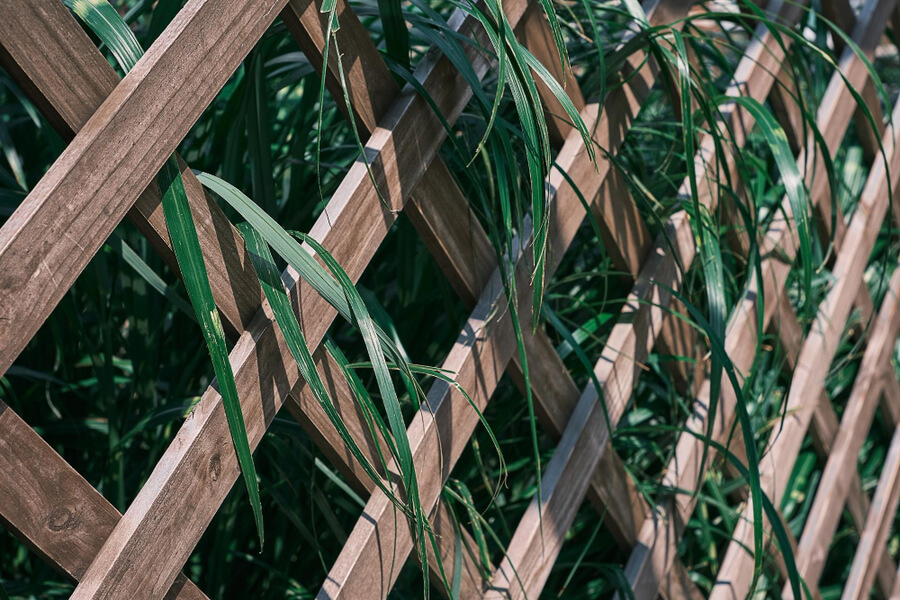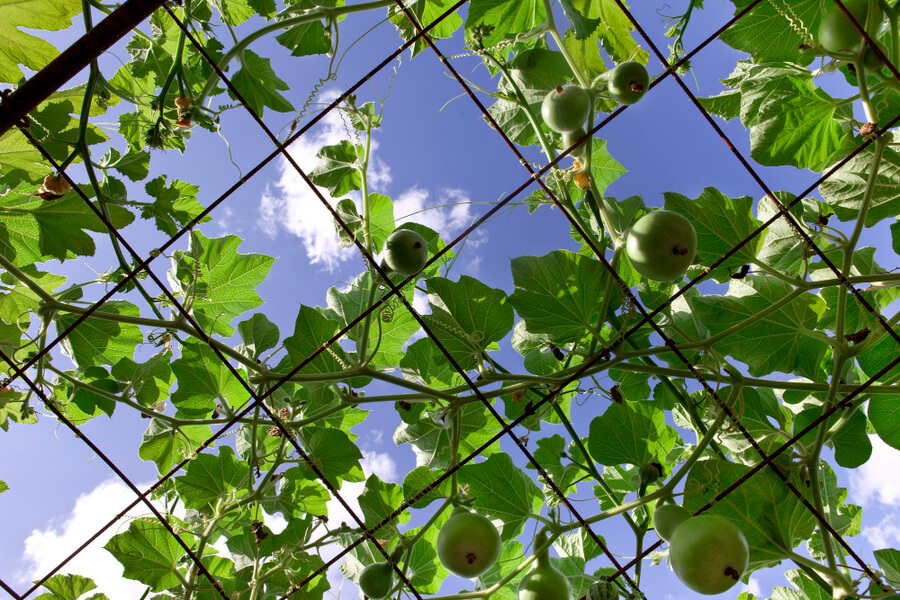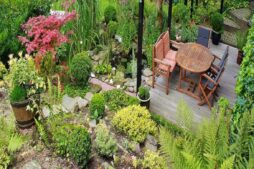A trellis is a near-perfect addition to a garden. Aesthetically pleasing and a gardener’s dream, these beautiful frameworks provide the ideal support for fruit trees and climbing plants. Plus, adding a trellis is a lovely way to create privacy in a garden. For complete privacy, attaching trellis to fence panels is ideal. By adding trellis to existing fence and planting a few climbing plants, you can create privacy, add some style to your garden and support existing plants – all with one piece of framework! So, here’s how to attach trellis to fence in your garden.
What’s The Point of A Trellis?

Your garden can benefit from the addition of greenery while also making use of unused space thanks to a trellis. Understanding how to attach trellis to fence can increase your level of seclusion and provide the ideal framework for adding some foliage. Plus, a trellis can hide a lousy fence and is discreet. Finally, climbing plants spreading across the frame are the perfect solution for tiny spaces that need an infusion of foliage and colour because they require little care and only occasional pruning. Here’s a simple guide to building your trellis.
Things To Consider When Adding Trellis To Existing Fence:
Before we go into how to attach trellis to fence, there are a few things you should consider to ensure you make the most of your frame. After all, you certainly don’t want it falling as soon as you put it up! So here are a few things you should be sure of before adding trellis to existing fence:
- Select structures that will hold up to the weight of the desired vines.
- Consider whether you want the trellis to serve as a decorative element in your landscape, highlight the vegetation or boost your garden buildings.
- Consider the types of plants you wish to grow. For example, a runner bean needs a different kind of trellis from a tomato or cucumber vine. On the other hand, climbing jasmine requires a different sort of trellis than a sweet pea.
- Many various trellis designs will keep away peeping Toms and wandering people. Preparing or painting your trellis before attaching it to a fence is wise. This makes it easier to access all of the trellis’s gaps and crevices, giving it optimal shelter from the elements. Before installing, let the surface dry for an hour.
How To Attach A Trellis To A Fence

Things you’ll need:
- Trellis
- A fence with battens
- Screws
- Drill
- The first step is to make sure there is climbing room for the plants. To guarantee sufficient space for growth, ensure you can thread your finger around the trellis.
- Once you know you have a lovely framework that provides room for growth, you must secure the trellis to a batten. A batten is a piece of metal or wood on which you can fasten things, and they are usually already on your garden fence. The size of the batten will depend on the size of your trellis. At the spots where the top and bottom of your trellis will sit, fasten it to the fence.
- Consider adding an attachment in the centre as well if your trellis is substantial, or your planting may make it weigh a fair amount.
- Finally, attach a trellis to your fence. Drill a screw through your trellis, directly onto your batten. Continue until it is firmly secure and you’re ready to plant!
How To Attach A Trellis Without Drilling
If you’re asking yourself how to attach trellis to fence without drilling or using screws, you can buy a variety of outdoor super glues that will hold everything in place. Another alternative for how to fix a trellis to a fence without drilling is to use plastic zip ties, but you will need to ensure that they are long enough to reach around your fence.
You can confidently attach trellis to fence or a wall as long as you firmly embed your battens into the ground. However, a cure on your trellis base may still rot if it is constantly in contact with the damp earth, so be careful it is not touching the soil in your garden that will become wet every time it rains.
Fixing A Trellis To a Fence Without Posts

How to fix trellis to fence without posts is a similarly straightforward process. You can apply lattice in a number of ways to improve your garden’s aesthetics. If you don’t have any posts to connect your trellis to, you may just affix it to the top of the fencing panels. This works well to add height to an established fence or serve as an independent component to divide different landscape regions.
Do You Need Planning Permission For A Trellis On Top Of Fence?
The maximum height for a fence always includes any trellis. Therefore, it’s crucial to remember that a trellis extension at the top of the fence is also regarded as a component of the fence. Currently, the legal fence height in the UK is 2 metres, or 6 feet 6 inches[i]. So, you will have to seek planning permission if the trellis will increase your structure beyond this allowed height.
Read More: Do You Need Planning Permission For A Shed?
Climbing Plants To Grow On Your Trellis

A wonderful approach to enhance the beauty and intensity of your garden is through vertical planting. And a trellis gives you the perfect opportunity to give it a try! Many climbing plants will happily grow and spread on a trellis. If you’re curious to know what plants thrive on a trellis, here are a few plants you can grow:
- Ivy, clematis, and honeysuckle are a few plants that may clamber and can flourish if you end up leaving them unattended.
- Vibrant, lovely blossoms on nasturtiums are not only attractive to gaze at, but they are also tasty! A fantastic ingredient to toss into your dishes or add to your flower garden.
- Sweet peas are little vining species ideal for outdoor trellises and pots. They are aromatic climbing vegetables with lovely blossoms. Sweet peas are simple to cultivate, although they do best in the fresher springtime and autumn months.
- You are fortunate if you can grow bougainvillaea in your backyard! Only in hot conditions will this one flourish. Most, if not all of the time, the colourful blossoms on this densely vining plant are all you can see!
- Gardeners typically plant petunias as hanging plants. However, they also work well as trellis plants. They are ideal for growing in containers or can be coaxed into growing vertically on a little trellis. Petunias do well in the sunshine but thrive in partial shade.
- Clematis is a favourite trellis plant because of how swiftly it spreads and how effortlessly its sticky limbs can grip to things. Furthermore, it’s improbable to spiral out of control. You may choose a clematis that suits your interests or garden décor because they come in various flowering colours. For the most brilliant flowers, leave clematis in direct sunlight.
- The butterfly vine is the ideal climbing vine to draw insects! Its name refers to its seed pods, which are styled like butterflies, rather than its capacity to attract pollinators. In temperate conditions, the butterfly vine develops as a perennial, although northern horticulturalists can grow it effectively as an annual. The rising plant may accept little shade, but whole light will produce more of the tiny yellow blooms.
Adding Trellis To Existing Fence: In Summary
Trellises serve more than just the duty of supporting your plants’ growth. They are also stunning and always catch the eye. Even in the harshest of seasons, when everything else may be motionless, your trellis will offer a vertical flair to your environment. Your trellises will be clothed in foliage during the peak of growing seasons. By choosing a trellis that matches your home’s building style, you can even establish a feeling of cohesion between your home and your garden.
Do you have any tips on adding trellis to existing fence? Let us know your advice!
Sources
[i] https://propertypressonline.co.uk/2022/06/24/fence-height-uk-questions-answered/
Ryan Jenkins is a professional gardener and has been working in the gardening industry for over 25 years. This has allowed Ryan to accumulate a vast wealth of gardening knowledge which he shares on the Sefton Meadows blog.




